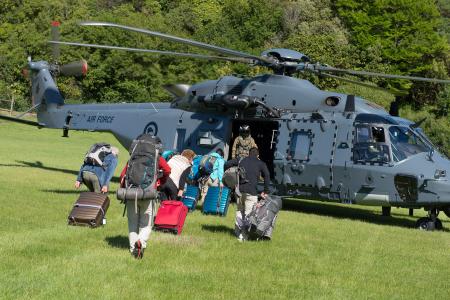
By Lincoln Feast and Charlotte Greenfield
WELLINGTON (Reuters) – New Zealand emergency services and defence personnel began evacuating hundreds of tourists and residents from the South Island town of Kaikoura on Tuesday, a day after a powerful earthquake hit the region, killing two people.
The 7.8-magnitude tremor struck just after midnight on Sunday, destroying farm homesteads, sending glass and masonry toppling from high rises in the capital, Wellington, and cutting road and rail links throughout the northeast of the ruggedly beautiful South Island.
Kaikoura, a popular base for whale-watching about 150 km (90 miles) northeast of Christchurch and near the epicentre, was completely cut off by massive landslips.
Four large defence force helicopters were flying in to the town on Tuesday morning and the Navy’s multi-role vessel HMNZS Canterbury was heading to the area, Air Commander Darryn Webb, the acting commander of New Zealand joint forces, told TVNZ.
“The priority today is the airlift operation,” he said. “We’re looking to do as many flights as we can out of Kaikoura today … around about four flights, to move approximately 200 of those tourists and residents south.”
Other emergency services were also using helicopters to fly in supplies and fly out those who wanted to leave, Civil Defence’s acting national controller Shane Bayley told reporters.
Around 1,200 tourists had been stranded in the town, officials said.
Mark Solomon, leader of South Island indigenous Maori Ngai Tahu tribe, which has tourism and fisheries businesses around Kaikoura, said the local marae (Maori meeting place) had received 1,000 people since Monday morning. Many slept overnight in the communal hall or in vehicles outside.
The tribe had been feeding those trapped with crayfish, a delicacy for which the South Island town is famous. With no power, the tanks that hold the expensive crustaceans stopped pumping.
“It’s better to use the food than throw it in the rubbish so we sent it up to the marae to feed people,” Solomon told Reuters by phone.
AFTERSHOCKS, WIND AND RAIN
Gale-force winds and rain were hampering recovery efforts, and hundreds of aftershocks continued to rock the region.
China chartered four helicopters and evacuated around 40 nationals, mostly elderly and children, from Kaikoura late on Monday, said Liu Lian, an official at the Chinese Consulate in Christchurch.
One Chinese national had been treated for a minor head injury in Kaikoura’s hospital, and around 60 others would be evacuated on Tuesday, Liu said.
“They have been trapped in Kaikoura for a couple of days, some are maybe scared, they have some mental stress,” Liu told Reuters, adding that many planned to continue journeys to other parts of New Zealand.
Prime Minister John Key flew over Kaikoura on Monday and described the landslides in the mountainous area as “just horrendous”. The repair bill was likely to run into billions of dollars, he said.
Civil Defence estimated 80,000-100,000 landslides had been caused by the quakes.
Acting Civil Defence Minister Gerry Brownlee said restoring water supplies, getting food into Kaikoura and clearing road access were the main priorities.
New Zealand had accepted an offer from the U.S. Navy of two helicopters on board its destroyer the USS Sampson, which was in the country for a naval review, Brownlee said. The Defence Force had also accepted an offer of help from the Japanese military, he said.
New Zealand media reported long queues at grocery stores and petrol stations in Kaikoura.
Workers began returning to office buildings in Wellington’s business district, which was closed off on Monday while the city council assessed the risk to buildings.
Several blocks were damaged by the tremor, including the offices of Statistics New Zealand, which halted the release of economic data and said it would be months before it could use the building.
Many businesses told staff to work from home.
New Zealand’s Geonet measured Monday’s main quake at magnitude 7.5, while the U.S. Geological Survey put it at 7.8.
Seismologists said the quake appeared to be two near-simultaneous tremors that shook much of the country for around two minutes.
New Zealand lies in the seismically active “Ring of Fire”, a 40,000-km arc of volcanoes and oceanic trenches that encircles much of the Pacific Ocean.
Christchurch, the largest city on New Zealand’s ruggedly beautiful South Island, is still recovering from a 6.3 magnitude quake in 2011 that killed 185 people.
(Additional reporting by Swati Pandey in SYDNEY; Editing by Andrew Roche and Paul Tait)